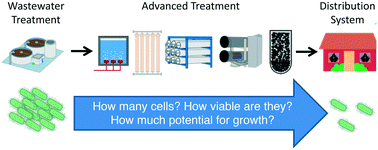Removal and growth of microorganisms across treatment and simulated distribution at a pilot-scale direct potable reuse facility†
Abstract
Multi-barrier advanced treatment trains have been shown to purify wastewater to drinking water standards, but improved methods are needed to better understand microbial concentrations, viability, and growth potential throughout treatment and distribution systems. In this study, bulk water cell counts, adenosine triphosphate concentrations, and assimilable organic carbon were measured throughout a pilot-scale direct potable reuse facility and three parallel chlorinated simulated distribution systems fed with the pilot's finished water. We also investigated the impacts of treatment operations (e.g., membrane cleanings) and perturbations (e.g., incomplete wastewater nitrification) on microbial water quality. Intact cell counts and total adenosine triphosphate concentrations were reduced to near or below method quantification limits (22 cells per mL and 10−4 nM, respectively) by reverse osmosis and advanced oxidation. Total cell counts and assimilable organic carbon concentrations were consistently above method quantification limits (12 cells per mL and 10 μg L−1, respectively) in finished water (i.e., granular activated carbon filtrate). However, assimilable organic carbon levels in finished water were lower than values typically measured in conventional drinking water systems in the United States, and cell counts were dramatically reduced by batch chlorination. Occasional ammonia passage through advanced treatment caused large variations in chlorine demand in finished water, and a strong inverse correlation was observed between cell counts and residual free chlorine in the simulated distribution systems. We show that multi-barrier advanced treatment reliably rejects wastewater-derived bacterial cells, and that the methods applied herein can provide complementary information to traditional monitoring approaches to evaluate microbial water quality throughout treatment and distribution.



 Please wait while we load your content...
Please wait while we load your content...